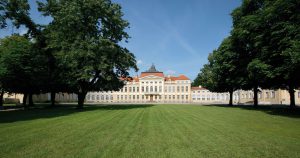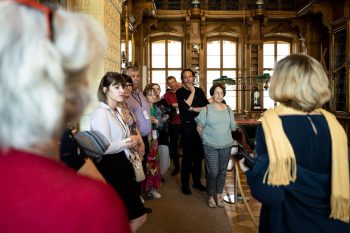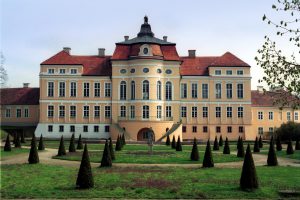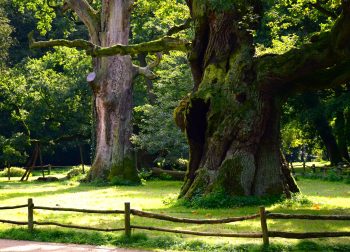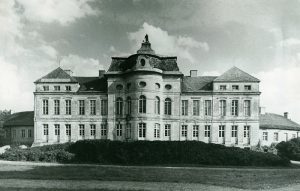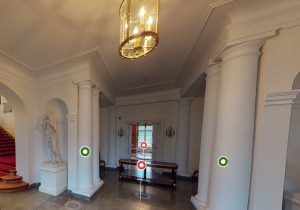The educational offer of the Museum Palace in Rogalin includes: museum lessons, workshops, cyclical educational activities (holiday, summer, occasional), guided tours of all exhibition spaces. It is addressed to organized groups of 10-25 people of preschool age (5 years old), school age at different levels of education, also to children with special educational needs, adults, people with intellectual disabilities (groups of 10-15 people), blind and visually impaired (groups of 10-15 people).
Organizing and reserving museum lessons and workshop classes
- Museum lessons last 45-60 minutes and have the form of lectures, discussions, debates, games, pantomime activities and take place in groups of 10-25 people, cost: 70 PLN per group + admission tickets.
- Museum lessons with workshops last 75-90 minutes and consist of a theoretical and practical part: plastic or dance, take place in groups of 10-25 people. Cost: 100 PLN per group + admission tickets.
- Museum lessons with workshops for people with disabilities last 45-60 minutes, consist of a theoretical and practical part: plastic or dance, take place in groups of 10-15 people. Cost: 70 PLN per group + admission tickets.
- Museum lessons and lessons with workshops during holidays, vacations, occasions, activities related to temporary exhibitions are cyclic classes, take place in groups of 10-25 people, subject to a different price list.
- Museum lessons and workshops are held from Tuesday to Friday, starting from 9.30-14.30.
- Lessons and workshops are conducted on the basis of a previously made phone order: 61 813 88 29, 61 813 88 00 (8.00-16.00) and by e-mail: rogalin@mnp.art.pl, at least a week in advance, no earlier than 3 months before the planned visit. Confirmation of the reservation by phone is mandatory by e-mail! Reservation Regulations
- During the museum activities we move around the exhibition in accordance with the guide’s / person leading the classes recommendations.
- We keep quiet so as not to disturb other visitors.
- During tours and museum lessons as well as workshops we can take pictures of the exhibits without using a flash.
- The museum provides materials for the plastic part of the classes.
- The meeting place depends on the place of the class, you will be informed about it when buying tickets at the museum ticket office.
- We ask for punctuality. Delay of over 15 minutes may result in shortening or canceling classes / tours.
- Teachers and guardians are responsible for the behavior of their charges in accordance with the museum regulations during educational classes and the entire visit to the museum. Their presence at lessons, workshops and during the tour is necessary. Museum Visitor Regulations, Park and Garden Visitor Regulations.
Touring with a guide (45 minutes)
- Guided tour of the main part of the palace – rooms on the ground floor and piano nobile
- Guided tour of the north wing – Ancestors’ Gallery and London Cabinet
- Guided tour of the hidden corners of the palace – south wing
- Guided tour of the Picture Gallery
- Guided tour of the Coach House
- Guided tour of the garden and park
Museum Lessons / Thematic Tours (45-60 min)
Museum lessons/themed tours are conducted based on a previously placed telephone order: 61 813 88 29, 61 813 88 00 and by email: edukacja.rogalin@mnp.art.pl, with at least one week’s notice, no earlier than three months before the planned visit. Telephone reservations require confirmation by email.
Museum lessons/theme tours last 45-60 minutes, take the form of lectures, discussions, and debates, take place in groups of up to 25 people, activities in the Park and Garden in groups of up to 30 people, cost: 70 PLN per group + entrance tickets.
Educational activities in individual exhibition spaces:
Corpus of the Palace:
Adventure in the Palace
This is a proposal for an active tour of the palace. During the joint journey with the guide, children will get to know the former owners of the residence, search for the Nałęcz coat of arms and recognize the functions of the rooms on both floors.
Edward Raczyński – a dreamer and a pragmatist
The story of the life and deep patriotism of Edward Raczyński. Showing the versatility of his interests and work for the country against the backdrop of the Rogalin Palace interiors.
Museum lesson for classes 4-8 of primary school.
The Raczynski Countesses – beautiful, wise and wealthy? About the lives of women from the 18th to the 20th centuries
What were the women who belonged to the Raczyński family? What did they do? How did they find their place in the realities of their era? On the lessons, the profiles of the Raczyński Countesses and their accomplishments and contributions to the social and cultural activities of the family from the 18th to the 20th century will be presented. Will there be femme fatales from romantic novels among them?
Museum Lesson for 7th and 8th Grade Primary School and High School Students
Collectors and Patriots. About the Activities of the Raczynski Family over the Centuries
Who were the Raczyńskis? Outstanding patrons, collectors, patriots and donors. “Parsimonious to themselves, helpful to the poor, generous to their country”. Unusual figures, often controversial. How did they cope in difficult times of partitions, taking up the fight for a country that did not exist? During the classes we will get to know Edward I’s Rogalin Armory, we will see the collection of portraits of Atanazy Raczyński’s ancestors located in the northern wing of the palace and Edward Alexander Raczyński’s Picture Gallery.
Museum Lesson for 7th and 8th Grade Elementary School and High School Students
How to Illuminate a Palace? A Tale of Life Without Electricity
During the lesson we will get to know different ideas for dispersing darkness used before the invention of electricity. We will check how candles, lamps, chandeliers were presented in palace interiors. We will determine whether a chandelier can be made of porcelain and whether a lampshade always meant the same thing. We will find out what a wax candle, stearic candle, olive oil lamp and kerosene lamp look like. We will find out who invented the kerosene lamp.
Museum Lesson for Classes 1-8 of Primary School
North Wing: London Cabinet and Ancestors Gallery:
Do not waste Independence. Edward Bernard Raczyński
Based on the biography of Edward Bernard Raczynski, the participants of the class try to answer the questions: what is patriotism? What is freedom? And independence? The participants of the class discover the answers to these questions by taking on the role of the hero of the lesson.
Museum Lesson for Classes 1-8 of Primary School
Man and History
The exceptional biography and accomplishments of an extraordinary man: Edward Bernard Raczyński, the last owner of the Rogalin Palace, President of Poland in exile, lived to the impressive age of 101. He was well aware of what freedom, independence, and patriotism meant to the Poles who had to fight for them for over a century. He knew their value and tried to pass it on to the next generations with the words “Do not waste independence”! The activities conducted in an interactive and activating form of a “quiz show” present Raczyński’s accomplishments, the realities of the times in which he lived, and the space of his work in the recreated London Cabinet in Rogalin.
Museum Lesson for 5th to 8th grade Elementary and High School
Who was who? Or how did people manage in the days before Facebook?
About Genealogical Trees and Portrait Galleries.
Today it takes just one click and we know almost everything about someone. But how did it look like 200, 300 or even 1000 years ago? How was memory of ancestors kept and how were their images commemorated? Who was who in the times before Facebook? How could one find out? What ways of discovering and still uncovering the history of your family members? A story about the incredible personalities of the Raczyński ancestors and ways of transferring and preserving information about their life and descendants. Together we will learn how to read and create a family tree as well as how to search for hidden information in portraits and photographs.
Museum Lesson for 3rd to 8th Grade Elementary and Secondary Schools
ART GALLERY:
On the ART TRAIL! An exceptional tour of the gallery for the youngest ones
How to interest children in art and find their way through a maze of pictures? Nothing could be simpler, just turn the usual gallery visit into an amazing adventure. Rhymes and riddles will guide little discoverers to the right work of art. All that is needed is a good mood and a bit of imagination to get through our museum labyrinth!
Classes from 0 to 5, primary school, preschoolers
How to describe a painting?
How to translate a painting into words? What words to use to describe what the painter expressed on the canvas? During a museum lesson, participants learn how to make a basic description of a painting based on the paintings in the Rogaliński Gallery. Using this knowledge, they first go in search of paintings for which they only have a description, then they try to create a description themselves, so that their peers can find the image presented by them.
Museum Lesson for Classes 6-8 and High Schools
Recipe for a Portrait
The class is discussing one of the classic topics that has been appearing in painting for centuries. A portrait is a representation of a person or a group of people made by an artist. But is this explanation really so simple? During the class we will learn how many types of portraits can be distinguished, what else can be read from the portrait besides the appearance of the characters and why people started to preserve the images of different people.
Museum Lesson for Classes 4-8 and High Schools
Not Always Melancholia: On the Art of Young Poland
How far does an apple fall from the apple tree? It turns out quite far! A student may differ greatly from their painting master. The directions and most important works of art of the Young Poland gathered in the Rogalin Gallery of Paintings will be discussed in class. Great rebels, connoisseurs of beauty, eccentrics and… their oddities. Malczewski, Mehoffer, Wyspiański, Pankiewicz, Weiss, Boznańska. Outstanding artists whose works we will present in a non-conventional way, as is appropriate for the art of this period. Take part in an exceptional new art game with this ephemeral!
Museum Lesson for Classes 6-8 and High Schools
Understand Malczewski. Decoding a work of art.
Filled with symbols and figures from the border of the real, magical and mythological worlds. Intriguing works of the greatest Polish symbolist adorn the Polish room of the Rogalin gallery. You can understand Malczewski by reading his paintings according to a special key. We will recreate it together! Activities are intended for young art lovers and seekers of artistic puzzles.
Museum Lesson for Class 7-8 and High Schools
CARRIAGE HOUSE:
Far and near travels.
The lesson is taking place in a carriage house, surrounded by historic vehicles. The children will see how people used to travel, how the old trunks, carriages and sleds looked like. Each participant will solve puzzles and riddles on their own.
Museum Lesson for Classes 1 to 8 of Elementary School
GARDEN AND PARK:
Native Trees and Shrubs
How can they be recognized and distinguished? What is their symbolism and meaning in the context of the beliefs of the ancient Slavs? The activities take place in the park.
Museum Lesson for Classes 0-8 and Secondary Schools
Oak trees of Rogalin – icons of the Greater Poland landscape
The naturalistic character of the historic landscape park and its significance for the preservation of the historic trees. Activities take place in the park.
Museum lesson for classes 7-8 and high schools.
Why are we saving old trees?
The meaning of old trees in the natural and cultural landscape, as well as methods of their care taking into account the presence of protected by law insects, on the example of the dendroctonus bark beetle. The activities take place in the park.
Museum Lesson for Classes 7-8 and High Schools
What do the Rogalin oaks whisper about?
The classes take place in a park, among the majestic, ancient oaks, which remember the times of the Slavs living in these lands, as well as the transformations which were initiated by Mieszko I in 966, and later by Bolesław Chrobry.
Museum Lesson for 7th and 8th Grade and High Schools
SOUTH WING:
Adventure in the Nooks and Crannies
Following in the footsteps of the former residents of the palace, the participants explore the normally inaccessible rooms in the south wing of the palace and its cellars. They compare old customs with today’s and have a great time doing it.
Museum Lesson for Grades 1-3 of Elementary School
SEASONAL OFFER:
At the Palace: Christmas, Easter, Vacations, Holidays
Art classes tailored to the theme.
Museum lessons with workshops are based on a prior telephone order at 61 813 88 29, 61 813 88 00 and an email order at rogalin@mnp.art.pl, with at least one week’s notice, no earlier than three months before the planned visit. Telephone reservation requires confirmation by email. They last 75-90 minutes and consist of a theoretical and a practical part: artistic or dance, they take place in groups of up to 25 people, cost: 100 PLN per group + entrance tickets.
The Palace Corpus:
About Noble Customs – Card Game
We invite all card game lovers! The participants, divided into four teams, are facing 16 levels of tasks. What was life like for a nobleman in a rural residence? What rules did he have to follow? Who was he supposed to listen to? Where was he allowed to sit, what to say, how much to drink and eat? How were holidays celebrated? What superstitions were believed? Noble customs added color to every day in the palace. We will tell you about the strangest and most important ones while visiting the interior of the Rogalin Palace.
Workshops for grades 3-8 and high schools
To the rescue of art. About the conservation of monuments.
What does a conservator’s workshop look like? Which exhibits in the palace interiors are original and which are recreated? How thin are gold flakes? How long does it take to glue a porcelain chandelier? … and what can be done with a squirrel’s tail? Together, we will learn the secrets of the conservation treatments applied to selected exhibits. At the end of the workshop, participants will gild a plaster figurine by hand.
Workshops for grades 3-8 and high schools
How to Illuminate a Palace? A Tale of Life without Electricity.
During the lesson, we will learn different ideas for dispersing darkness used before electricity was invented. We will check how candles, lamps and chandeliers looked in palace interiors. We will determine whether a chandelier can be made of porcelain and if the lampshade always meant the same thing. We will find out what a wax candle, a stearin candle, an olive oil lamp and a kerosene lamp look like. We will find out who invented the kerosene lamp. Then each participant of the lesson will decorate their own candle holder or lantern.
Workshops for grades 1-8 of primary school
On the old photo
Where do the photos in the palace come from? What can we learn from them? Has the technique of taking photos changed? During the classes we will find out what we can find on old photographs and why they are particularly valuable. We will find out the ancestors of photography and its sources. And also learn that photos are not just selfies. The culmination of the classes will be the construction of the device – camera obscura and a visit to the photographic exhibition “70th anniversary of the opening of the Palace Museum in Rogalin”.
Workshops for 4th-8th grade elementary school
What is your sign? We have coats of arms for both big and small.
The mysterious coat of arms of the Raczynski family appears almost in all of the palace rooms. Yet, what does it really mean? What are its components? What is the jewel and the shield? What is the difference between the coat of arms and the crest? Could everyone use it? How do the full of amazing adventures heraldic legends come to life? We invite the brave ones who will join us in search of and discover the mysteries of the 3 Raczynski coats of arms and the knights that used them. The workshop ends with a craft activity, during which participants will decorate a knight’s shield with their own handmade coat of arms.
Workshop for grades 1-5 of primary school
North Wing: London Cabinet and Ancestors Gallery:
About Youth and Customs in the 19th Century
Beautiful dresses and men in wigs, or what the palace inhabitants dressed like and how they behaved over 200 years ago? Join us on an exceptional journey to the times when crinolines were worn. By carefully looking at the portrayed women and their accompanying men from the Raczyński family, we will see how fashion changed. We will literally put on costumes from the era. We will check if it was comfortable to walk and sit in a corset, crinoline, huge hats and wigs. The workshop ends with a practical part – making a fan or a cylinder. Workshops take place in the exhibition of ancestors gallery and in the 19th-century tailoring workshop.
Workshops for classes 2-8 and high schools
The southern wing of the palace, nooks and crannies:
In the painter’s room
At Rogaliński Palace there is a special room dedicated to the artist-painter. What kind of mysterious objects can be found there? What are they used for? What did the artist’s studio look like at the turn of the 19th and 20th centuries, his atelier? Join us in the room-studio of Jacek Malczewski and Leon Wyczółkowski. During the workshops, we will follow the painter’s trail and visit the Gallery of Paintings. In the practical part, participants of the workshops will independently make oil paints and try to copy the colors of the master! They will also find out that you can paint not only with brushes. Together we will test sponges and various shapes of spatulas. So – palettes in hand!
Workshops for classes 2-8 of primary school and secondary schools
The Secretary’s Secrets – Calligraphy Workshop
In the 19th century, the ability to write graceful and decorative letters was essential. Thousands of letters and invitations written to this day adorn the archives of palaces and private libraries. What if we were to uncover the secrets of a secretary desk for a moment? We will jointly explore a brief history of the development of writing from antiquity to the present day and learn how to write with a quill pen and a dip pen. At the end of the workshop, participants will decorate a handmade invitation with text and a golden initial.
Workshops for grades 3-8 and high schools
Kleksography: A Fun Introduction to Calligraphy for Kids
To describe the world, you have to know how to write. And that’s not an easy skill. Unless you approach calligraphy with a light heart. During the workshop we will check what can be created with a finger dipped in ink.
Workshop for pre-schoolers, primary school classes 0-3
Gallery of Paintings:
Secrets of Colors
Not only people, but also colors can hide secrets. Moving through the gallery space, we will pay attention to the basic concepts of color. The culmination of the acquired knowledge will be to create our own composition using pigments.
Workshops for 1st-4th grade of primary school
Animals in Art
“The wolf is wild, the wolf is wicked. The wolf has very sharp teeth”, yet is that really so? How are animals portrayed in art? Does what we hear about them in fairy tales and legends find confirmation in the paintings? What might a beautiful, colorful butterfly or a grasshopper painted by the artist mean to us? And is it easy to find our pets and bugs among the hundreds of paintings gathered in the gallery? Find out for yourself! The workshop ends with a creative part – making an ornament of a butterfly with moving wings.
Workshops for classes 1-4 of primary school
Educational Room:
Inside the museum
How does a museum work? Is it boring in the museum? Who works there? How to behave in the museum? To these, and many other questions, the participants of the “Museum from the Kitchen. Fun in the Museum” will get the answer. Participants will have the opportunity to take on the roles of different museum employees in order to familiarize children with the functioning of this institution through play.
Workshops for Primary School Classes 0-6
Children’s Museum
A visit to a place where you can see what a day in the life of children in a palace looked like, learn about old children’s games, view traditional toys and dress up in historical costumes. Activities for groups of 10-15 people.
Workshops for 5-year-old preschoolers, grades 0-1 of primary school
A ball at the palace
The participants of the class strive to understand what dance is, what its functions are, how the culture that we grow up in influences the form of dance and music, and come to understand the connection between dance and place and time. The conclusion of the class is the learning of a short dance routine based on the English contra-dance.
Workshops for Grades 1-5 of Elementary School
Embroidery lesson
How was clothing decorated when it had to be sewn by hand? What did ladies do on long evenings at the palace? What was the domain of a good candidate for a wife? The workshop will bring participants closer to various types of embroidery. Everyone will be able to make their own cross-stitch pattern.
Workshops for Grades 4-8 of the Primary School
Who are you? A Polish child!
Why is an eagle in the coat of arms and not another bird? Who wrote the “Mazurek Dabrowski”? Do the colors on the flag allow us to distinguish ourselves from other countries? During the classes, Polish national symbols and their origin will be discussed. The topic of the loss and recovery of Poland’s independence will also be addressed. The classes will end with a creative project.
Workshops for Classes 0-3 of Primary School
In the 19th century library
Edward Raczyński had a rich publishing activity. He published books, journals and catalogs. But was it easy to create such a volume? Apart from the development of the content, the book had to be published. During the workshop part of the classes, participants will have the opportunity to create a notebook on their own, using the method once used to compile books.
Workshops for 5th-8th grade elementary school, high school and high school students
The educational offer of the Rogalin Palace Museum addressed to people with disabilities includes: museum lessons with workshops, cyclical educational activities (holiday, summer, occasional), guided tours with guides around all exhibition spaces. It is addressed to organized groups of up to 10 people in pre-school age (5 years old), school age at different levels of teaching and adults.
Tour with a Guide:
Tours with a guide should be reserved by phone: +61 813 88 29, +61 813 88 00 or/and by email: edukacja.rogalin@mnp.art.pl, at least one week in advance, no earlier than 3 months before the planned visit. Phone reservation requires confirmation by email.
- Guided tour of the main palace corpus – rooms on the ground floor and piano nobile (45 min)
- Guided tour of the north wing – Gallery of Ancestors and Edward Bernard Raczyński’s London Cabinet (45 min)
- Guided tour of the palace nooks and crannies – south wing (45 min)
- Guided tour of the Picture Gallery (45 min)
- Guided tour of the Carriage House (45 min)
- Guided tour of the park and garden (45 min)
Museum Tours/Thematic Tours
Museum/thematic tours are held upon prior telephone order: 61 813 88 29, 61 813 88 00 and e-mail order: rogalin@mnp.art.pl, at least one week in advance, not earlier than 3 months before the planned visit.
Museum lessons / themed tours for people with disabilities last 45-60 minutes, consisting of a theoretical and practical part: plastic or dance, take place in groups of up to 10 people. Cost: 70 PLN per group + entrance tickets, free admission for carers.
Adventure in the Palace
This is a unique offer of an active tour of the palace. During the joint journey with the guide, children will get to know the former owners of the residence, look for the Nałęcz coat of arms, and identify the functions of the rooms on both floors. Then they will solve tasks in the educational booklet.
(45-60 min)
Location: main part of the palace and educational room (45-60 minutes)
“Palace Game”
A giant board game, dice, pieces, and a wonderful adventure. Together, we will explore the Palace and challenge each other in a game that reinforces basic information about the Raczynski Palace in Rogalin.
Location: Main part of the palace and educational room
What is your sign? About coats of arms for large and small.
The mysterious coat of arms of the Raczyński family appears in almost every room of the palace. But what does it really mean? What are its components? What is the jewel and the shield? How does the coat of arms differ from the crest? Could everyone use it? How are the full of amazing adventures heraldic legends created? We invite the brave ones who will join us in search and discover the secrets of the three Raczyński coats of arms and the knights who used them. The session ends with a creative part during which the participants will decorate the knight’s banner with a coat of arms created by them.
Place: Main Part of the Palace and Educational Hall
On the trail of art!
How to interest children in art and find their way in a real maze of pictures? It’s easy – just transform a typical gallery visit into an amazing adventure. Rhymes and riddles will lead young explorers to the right piece of art. All you need is a map, a good mood and a bit of imagination to go through our museum labyrinth!
Location: Art Gallery and Educational Room
Animals in Art
“The wolf is wild, the wolf is bad. The wolf has very sharp teeth”, but is it really? How are animals portrayed in art? Does what we hear about them in fairy tales and legends find confirmation in paintings? What might a painted beautiful, colorful butterfly, or grasshopper mean? And is it easy to find our animals and insects among the hundreds of pictures in the gallery? Find out for yourself! The activity ends with a creative part – creating a windmill with the theme of colorful butterfly wings or peacock feathers.
Place: Art Gallery and Educational Room
Four Seasons in Art
Is it easy to recognize the season captured by the artist? Is there a perfect pattern to paint a winter or spring landscape? How to portray the heat of summer using paint? Can a painting influence the perception of temperature? Which season is the most cheerful and which one the most colorful? We will check this out by looking at the works collected in the Rogalin gallery of paintings. Finally, we will make a thematic work of art adapted to the season visible through the window.
Location: Art Gallery and Educational Room
Recipe for a Portrait
The class discusses one of the classic topics that have appeared in painting for centuries. A portrait is an image of an individual or a group of people created by an artist. But is the explanation that simple? During the class, we will learn how many types of portraits can be distinguished, whether we can read something else from the portrait besides the appearance of the characters and why people started to record the images of different people.
Location: Art Gallery and Education Room
In the painter’s room
At Rogaliński Palace there is a special room dedicated to the artist-painter. What kind of mysterious objects can be found there? What were they used for? How did the artist’s workshop look like at the turn of the 19th and 20th centuries, his atelier? We invite you to the room-workshop of Jacek Malczewski and Leon Wyczółkowski. During the workshops we will follow the painter’s trail and visit the Picture Gallery. In the creative part, the workshop participants will make their own oil paints and try to copy the colors of the master! They will also find out that you can paint not only with brushes. Together we will test sponges and various shapes of spatulas. So – palettes in hand!
Location: Educational Hall, Painter’s Room, Picture Gallery
Children’s Museum
A visit to a place where you can see what a day in the life of a child in a palace looked like, learn about old children’s games, watch traditional toys and dress up in historical costumes. Activities for groups of 10-15 people.
Place: Children’s Museum
Kleksography is a fun introduction to calligraphy for the youngest.
To describe the world, one must know how to write. That is not an easy task. Unless, of course, you approach calligraphy with a sense of fun. During the session, we’ll find out what can be created with a finger dipped in ink.
Place: Educational Room
Who are you? A Polish child
Why is an eagle in the coat of arms instead of another bird? Who wrote “Mazurek Dabrowski”? Do the colors on the flag allow us to distinguish ourselves from other countries? In the lesson, Polish national symbols and their origin will be discussed. The topic of Poland’s loss and restoration of independence will also be discussed. The lesson will end with a creative project.
Place: Educational Room
At the Palace: Christmas, Easter, Vacation, Holidays
Art classes tailored to the theme.
Place: Educational Room


